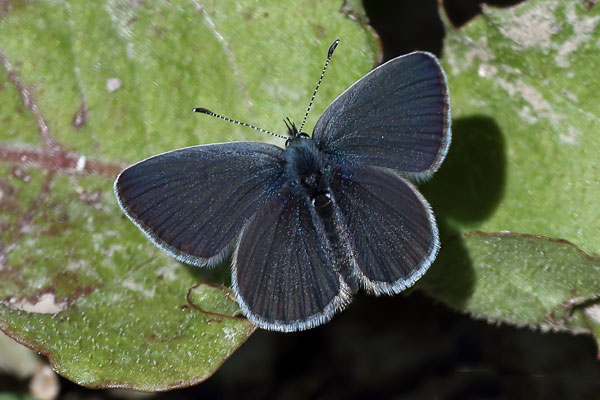 Male. Taken at Crog Hill, Oxon., on June 5th 2021. (© David Hastings) (1/640th sec at f11) 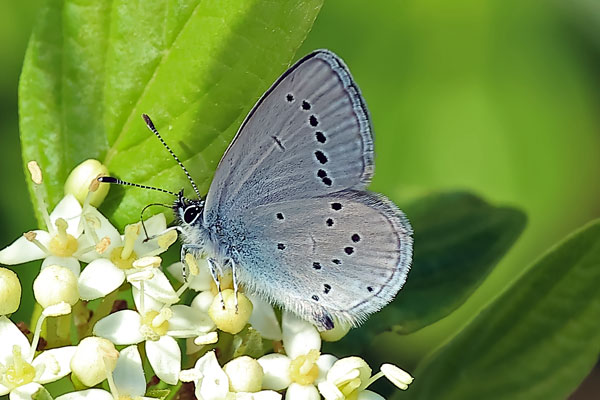 Male underside. Taken at Crog Hill, Oxon., on May 17th 2022. (© David Hastings) (1/640th sec at f11) 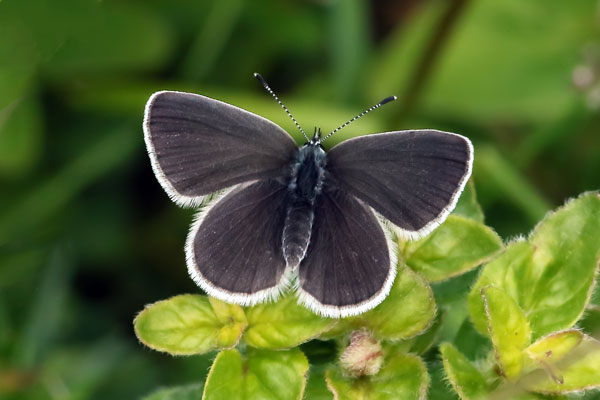 Female. Taken at Lardon Chase, Berks, on May 27th 2021. (© David Hastings) (1/640th sec at f13) 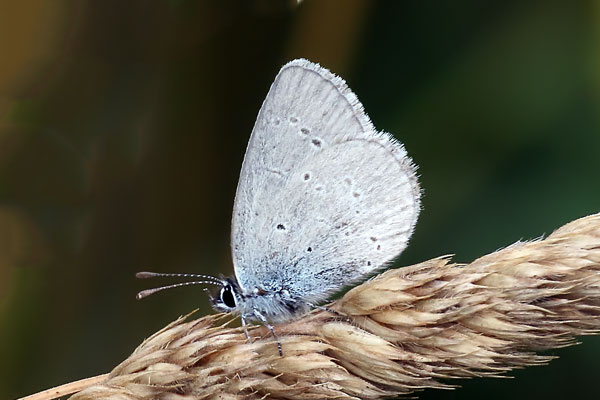 Female. Taken at Crog Hill, Oxon., on August 8th 2021. (© David Hastings) (1/400th sec at f11) 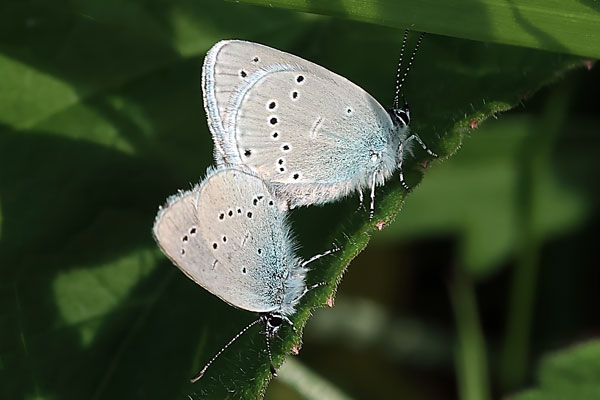 Mating pair. Taken at Crog Hill, Oxon., on May 17th 2022. (© David Hastings) (1/640th sec at f11) Description Family: Polyommatinae Wing span: 18 - 27 mm The Small Blue is the smallest British resident butterfly. The sexes are similar in appearance, although the male upperside is almost black with a dusting of blue scales, whereas the female is more dark brown in colour. Both sexes have a silvery-grey underside, which resembles that of the Holly Blue. Most colonies of this butterfly are in southern England and South Wales, with isolated populations in Cumbria, the Scottish Borders, and northern Scotland. In Ireland it is mainly a coastal species. Most colonies are on downloand or in quarries, but they are also found on road and railway verges. They prefer sheltered sites with sparse vegetation as these conditions suit the larval foodplant. Adults generally appear in early May in southern sites, reaching a peak at the end of May and beginning of June. There is a partial second generation in southern England, with adults appearing in late July and August. The larva is the over-wintering stage. The sole larval foodplant is Kidney Vetch (Anthyllis vulneraria). Adults will visit flowers such as Bird's-foot Trefoil and Kidney Vetch. Males gather in sunny sheltered areas, where they perch on tall grasses or low shrubs with wings half-open, ready to investigate any passing insect. Most adults stay within the colony, but some may move up to half a mile from it. Near Threatened Earliest UK sighting: 3rd May ; Latest UK sighting: 22nd August Sightings | 03-May-2025 | : | Crog Hill, Oxon | (14) | | 03-May-2025 | : | Hackpen Hill, Oxon | (4) |
| | 20-Jun-2024 | : | Hackpen Hill, Oxon | (1) | | 05-Jun-2024 | : | Pewsey Downs NNR, Wilts | (4) | | 19-May-2024 | : | Hackpen Hill, Oxon | (13) | | 19-May-2024 | : | Pigtrough Bottom, Oxon | (1) | | 19-May-2024 | : | Crog Hill, Oxon | (110+) | | 12-May-2024 | : | Hackpen Hill, Oxon | (2) | | 12-May-2024 | : | Crog Hill, Oxon | (31) |
| | 09-Aug-2023 | : | Hackpen Hill, Oxon | (1) | | 21-Jul-2023 | : | Aston, Oxon | (1) | | 13-Jul-2023 | : | Hackpen Hill, Oxon | (2) | | 11-Jun-2023 | : | Hackpen Hill, Oxon | (1) | | 07-Jun-2023 | : | Pewsey Downs NNR, Wilts | (1) | | 04-Jun-2023 | : | Hackpen Hill, Oxon | (7) | | 04-Jun-2023 | : | Crog Hill, Oxon | (120+) | | 15-May-2023 | : | Hackpen Hill, Oxon | (1) | | 15-May-2023 | : | Crog Hill, Oxon | (1) |
| | 10-Jul-2022 | : | Hackpen Hill, Oxon | (1) | | 12-Jun-2022 | : | Crog Hill, Oxon | (50+) | | 12-Jun-2022 | : | Hackpen Hill, Oxon | (1) | | 28-May-2022 | : | Hackpen Hill, Oxon | (6) | | 17-May-2022 | : | Crog Hill, Oxon | (100+) |
| | 04-Aug-2021 | : | Crog Hill, Oxon | (15) | | 19-Jul-2021 | : | Lardon Chase, Berks | (1) | | 05-Jun-2021 | : | Hackpen Hill, Oxon | (4) | | 05-Jun-2021 | : | Crog Hill, Oxon | (70+) | | 05-Jun-2021 | : | Seven Barrows, Berks | (1m) | | 01-Jun-2021 | : | Pitstone, Bucks | (22m,1f) | | 27-May-2021 | : | Lardon Chase, Berks | (2m,1f) |
| | 22-Jul-2020 | : | Crog Hill, Oxon | (40+m) | | 07-Jul-2020 | : | Lardon Chase, Berks | (4m) | | 20-May-2020 | : | Lardon Chase, Berks | (1m) | | 18-May-2020 | : | Seven Barrows, Berks | (4) | | 18-May-2020 | : | Crog Hill, Oxon | (80+) |
| | 27-May-2019 | : | Lardon Chase, Berks | (3f) | | 12-May-2019 | : | Pitstone, Bucks | (20+) |
| | 19-Jul-2018 | : | Vercors Natural Park, France | | | 21-Jun-2018 | : | Daneway Banks, Gloucs | (1) | | 26-May-2018 | : | Lardon Chase, Berks | (2) | | 20-May-2018 | : | Pewsey Downs NNR, Wilts | (2) | | 15-May-2018 | : | Lardon Chase, Berks | (1) |
| | 14-Jun-2017 | : | Daneway Banks, Gloucs | (1) | | 09-Jun-2017 | : | Paklenica National Park, Croatia | | | 06-Jun-2017 | : | Irinovac, Croatia | | | 28-May-2017 | : | Pewsey Downs NNR, Wilts | (7+) | | 07-May-2017 | : | Lardon Chase, Berks | (1m) |
| | 25-Jun-2016 | : | Daneway Banks, Gloucs | (1f) | | 29-May-2016 | : | Pewsey Downs NNR, Wilts | (20+m) | | 22-May-2016 | : | Lardon Chase, Berks | (6+m,1f) |
| | 22-Aug-2015 | : | Yeosden Bank, Bucks | (2) | | 16-Aug-2015 | : | Pewsey Downs NNR, Wilts | (5m) | | 24-Jul-2015 | : | nr Kirilova polyana, Bulgaria | | | 21-Jul-2015 | : | nr Petrovo, Bulgaria | | | 07-Jun-2015 | : | Aston Upthorpe Downs, Oxon | (3m) | | 07-Jun-2015 | : | Lardon Chase, Berks | (4m,6f) | | 16-May-2015 | : | Pitstone, Bucks | (50+) |
| | 16-Jun-2014 | : | Daneway Banks, Gloucs | (2f) | | 01-Jun-2014 | : | Dry Sandford Pit, Oxon | (1) | | 18-May-2014 | : | Lardon Chase, Berks | (2m,1f) |
| | 09-Jun-2013 | : | Cotley Hill, Wilts | (16+) | | 02-Jun-2013 | : | Lardon Chase, Berks | (4m) | | 01-Jun-2013 | : | Hackpen Hill, Oxon | (16+) |
| | 04-Jun-2012 | : | Seven Barrows, Berks | (2m) | | 31-May-2012 | : | Afton Down, Isle of Wight | (6m) | | 29-May-2012 | : | Afton Down, Isle of Wight | (10) | | 26-May-2012 | : | Lardon Chase, Berks | (4m) |
| | 19-Jul-2011 | : | Durlston NNR, Dorset | (3m) | | 04-Jun-2011 | : | Aston Upthorpe Downs, Oxon | (2m) | | 04-Jun-2011 | : | Lardon Chase, Berks | (2m,1f) | | 21-May-2011 | : | Seven Barrows, Berks | (1m) | | 07-May-2011 | : | Seven Barrows, Berks | (6) |
| | 05-Jun-2010 | : | Lardon Chase, Berks | |
| |






